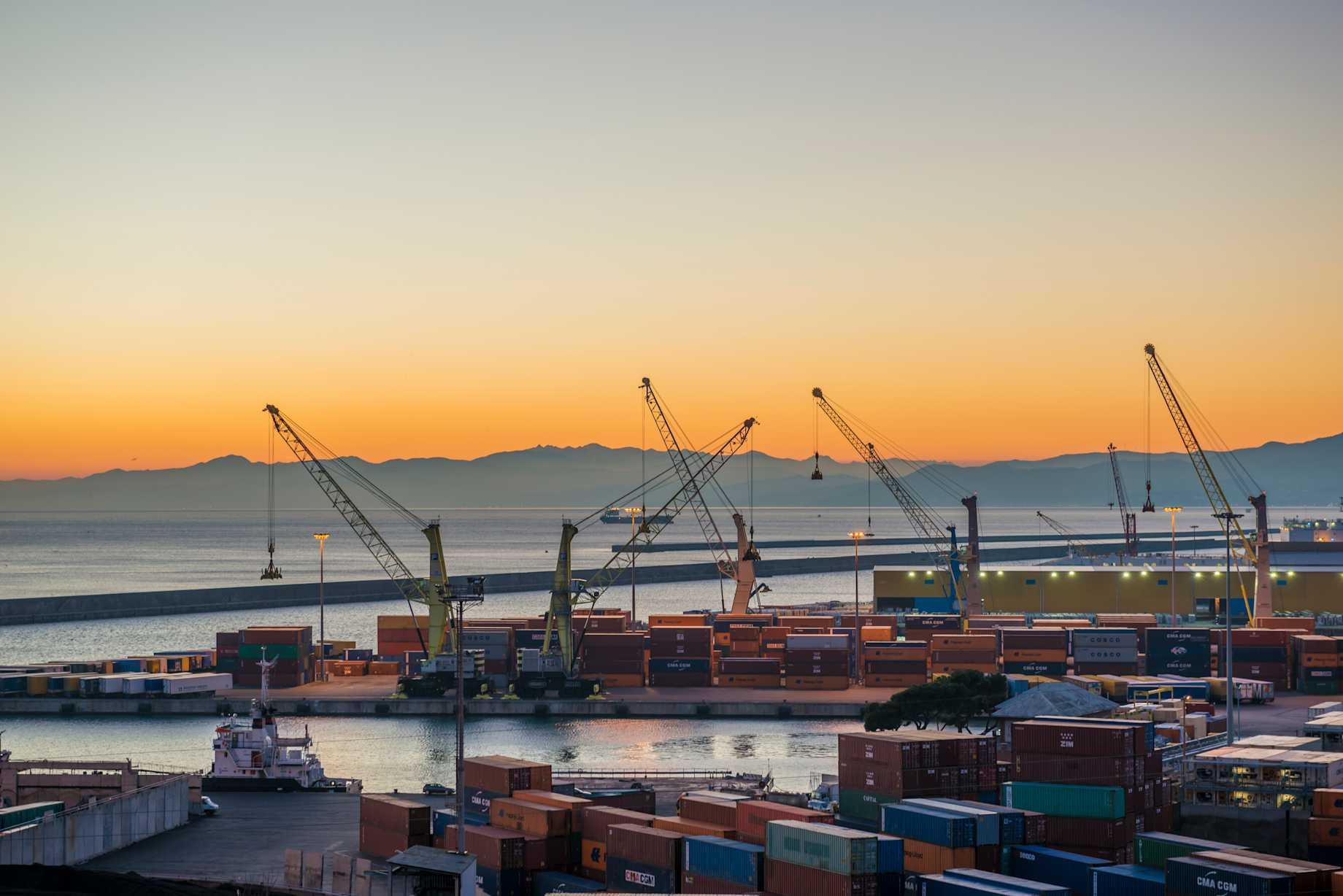Global Logistics Update
Freight Market Update: September 27, 2022
Ocean and air freight rates and trends; customs and trade industry news plus Covid-19 impacts for the week of September 27, 2022.
Freight Market Update: September 27, 2022
The State of Trade: Is the Supply Chain Crisis Over? | Thurs, September 29 @ 9:00 am PT / 12:00 pm ET
European Freight Market Update Live | Tues, October 4 @ 16:00 CEST / 15:00 BST
North America Freight Market Update Live | Thurs, October 6 @ 8:30 am PT / 11:30 am ET
Ocean Freight Market Update
Asia → North America (TPEB)
- Soft pre-Golden Week demand indicates a lack of traditional peak season—expect capacity reductions to follow.
- U.S.: Floating market rates leading into Golden Week continue to trend downwards—despite upcoming blanked capacity—prompting speculation about how rates might develop in the second half of October. Port and inland conditions are stable as transit times continue to see improvements.
- Canada: Market and rate conditions mirror the U.S. on Transpacific Eastbound (TPEB). Substantial delays persist for vessels berthing at Vancouver and Prince Rupert, although both are seeing incremental improvements.
- Rates: Rates remain soft on most origin-destination combinations.
- Space: Open.
- Capacity/Equipment: Open, except in a few pockets.
- Recommendation: Book at least 2 weeks prior to cargo ready date (CRD) and keep in mind upcoming blank sailings.
Asia → Europe (FEWB)
- Demand remains sluggish with no pre-Golden Week cargo rush. Space is available, despite schedule reliability continuing to be affected by a large number of blank sailings, vessel sliding, and port omissions.
- Serious port congestion in Europe, particularly Hamburg and Rotterdam, is causing further delays and late return of vessels to Asia.
- Rates: Ongoing pressure on spot rates due to low demand.
- Capacity/Equipment: Generally open space despite the impact of blank sailings and vessel delays.
- Recommendation: Allow flexibility when planning your shipments due to anticipated congestion and delays.
Europe → North America (TAWB)
- Capacity is expected to outstrip demand in Q4 2022, as carriers are likely to introduce more tonnage in the Transatlantic Westbound (TAWB) trade in view of attractive Dollar/nautical mile revenues. This capacity increase is likely to put downward pressure on freight rates in the upcoming weeks.
- Rates: For the first time in months we are seeing signs of rates dropping slightly, just not at the same pace as other trades. Most Q4 FAK are an extension of Q3 rates.
- Space: Still very tight on the U.S. East Coast (USEC) with some space open for direct routing to the U.S. West Coast (USWC). Some space is available out of Turkey.
- Capacity/Equipment: Equipment availability remains the biggest challenge for all EU origins, particularly in the Mediterranean region. Low empty stacks at inland depots, prioritize pick up from the Port of Loading.
- Recommendation: Book 4 or more weeks prior to CRD. Request premium service for higher reliability and no-roll.
- Read more: Congestion propping up trans-Atlantic spot rates: analysts
Indian Subcontinent → North America
- Growth in ISC exports to North America is strong over the first 6 months of 2022. JOC is reporting per PIERS data shows the numbers up 12.4% for January - June 2022.
- Rates: changes occurring with more velocity across the market. USWC being the most affected where rates are coming closer to TPEB levels. USEC rates are declining, but at a slower pace.
- Capacity/Space: Space is available across most lanes at standard (non-premium) rates. Decreases in port congestion globally are effectively increasing capacity as ships are experiencing less delays covering shorter periods of time.
- Equipment: Smaller ports and inland container depots (ICD) will continue to have sporadic deficits based on import/export cargo mix.
- Recommendation: Take advantage of declining rates.
North America → Asia
- USEC ports continue to see challenges with vessel congestion and some vessel strings still omitting Charleston and Savannah entirely. Erratic vessel schedules continue to cause significant challenges with changes in posted earliest return dates and vessel cut-offs at the port. For USWC, arrivals and available capacity for Los Angeles is generally open whereas Oakland and Seattle are more fluid.
- Rates: No GRI’s announced for September/October.
- Capacity/Equipment: Deficits on containers and chassis continue to plague Inland Port Intermodal (IPI) origins. Chicago remains the most reliable. Availability for standard equipment has not been an issue for most ports. Capacity from the US Southeast to India remains constrained due to continuing port omissions for Charleston and Savannah. Overall capacity for Indian ports requiring a transshipment service remains very tight from both the USEC and USWC.
- Recommendation: Please place bookings 4 weeks prior to vessel Estimated Time of Departure (ETD).
North America → Europe
- Congestion issues in North Europe, due to both the earlier labor actions at German ports and the current actions at several UK ports, are expected to persist.
- All carriers continue their booking stop for shipments to Ukraine, Russia, and Belarus.
- Rates: 2 carriers with the Ocean Alliance have announced nominal GRI’s for October.
- Capacity/Equipment: USEC service to Northern Europe has capacity available however Savannah has irregular challenges due to it being omitted on certain vessel strings. Vessel capacity from the port of Houston has been very tight due to a significant increase in demand and delayed vessels.
- Deficits are still plaguing many IPI origins. Availability for standard equipment at ports has not been an issue, but special equipment is hard to come by.
- Recommendation: Please place bookings 3 to 4 weeks in advance for East or Gulf Coast sailings and 6 weeks for Pacific.
North America Vessel Dwell Times

Air Freight Market Update
Asia
- N. China: Demand is weak prior to the Golden Week holiday. TPEB rates increased slightly from last week while Far East Westbound (FEWB) rates remain the same.
- S. China: Rates continue to drop in response to low market demand. Expect to see 1-2 days of additional transit time in regards to the Shenzhen-Hong Kong border situation.
- Taiwan: The market remains slack, however given the month and quarter end we anticipate weekend capacity to be slightly more constrained. Airlines also announced a fuel surcharge decrease effective Oct. 1.
- SE Asia: The Malaysian and Thai export markets continue to be soft with no signs of improvement. The Vietnam market is stable and extra capacity ex-Hanoi is being added to the market. Transit flights through Chinese hubs are tight due to anticipated flight cancellations for Golden Week.
Europe
- Demand remains low. Capacity available in the market continues to exceed current demand levels.
- Over the coming months, expect capacity to drop and rates to rise as passenger flight frequency decreases.
- Jet fuel prices are seemingly stabilizing at lower levels than earlier this year.
Americas
- Export demand remains steady from all markets.
- Demand to Hong Kong has seen a large increase.
- US airports are running at a normal pace.
- Capacity is opening up further, especially into Europe, where most carriers have increased the number of passenger flights for their summer schedules.
- Rates remain stable week over week.
- A heavy travel season in and out of Canada is putting a strain on the infrastructure of major airports (Vancouver and Toronto in particular) which is having a trickle-down effect on cargo operations. This is resulting in longer than normal dwell times for both import and export cargo.
- Air Canada has continued to add both passenger and freighter flights from all major gateways into both Europe and Latin America.
Trucking & Intermodal
UK/Europe
- UK trucking traffic is being impacted by extremely low water levels across the continent. This has brought inland navigation close to a full stop. Barges temporarily cannot go on the Rhine past Cologne, blocking the whole Western/South-Western part of Germany from being serviced via waterways. Low water fees apply for inland barge terminals in Germany & the Netherlands, as barges can only take half loads. This is putting pressure on Rotterdam/Antwerp capacity, as 38% of all containers move to/from Rotterdam via waterways, resulting in overbooked rail and truck options.
Americas
US Import/Export Trucking: Market Trends
- Canadian congestion continues with yard utilization >90% across the board, along with continued rail congestion. Efforts to mitigate congestion in Toronto and Montreal include CN opening additional relief container yards which could potentially impact drayage rates.
- Chassis shortages persist, notably in Chicago, NYNJ, Memphis (95% utilization, 10+ day street dwell time) and in LA (9.8 day street dwell for 40’, which is down ~1 day from August).
- East coast and gulf congestion continues with vessels at anchor in New York and Norfolk. Savannah congestion has increased to 42 ships (up from 36) awaiting berths at the end of August, with wait times in the 9-18 day range. Import container dwell time averages over 10 days.
US Domestic Trucking: Market Trends
- Tender rejections by carriers have decreased by 70% YoY from 20.8% to 6%, meaning carriers are accepting more loads due to having more capacity.
- Spot rates crept up in August by $0.02/mi after bottoming out at a 16-month low (down ~35% YTD). Contract rates followed after edging up for several months due to fuel surcharge (FSC) schedules.
- Load-to-Truck ratios have leveled out going into Q3 but are still down ~33% YoY. This is the key barometer for supply/demand in the marketplace.
Customs and Compliance News
Forced Labor Enforcement Significantly Increased in August 2022
CBP’s latest Monthly Operational Update included statistics showing a significant increase in forced labor enforcement. In August 2022, CBP targeted 838 entries valued at more than $266.5 million for suspected use of forced labor in the production of imported goods, including goods subject to the Uyghur Forced Labor Prevention Act and Withhold Release Orders.
CBP Ruling Finds No First Sale Despite Incoterms
In HQ H316892, published September 23, CBP responded to a request for internal advice regarding the acceptability of the “first sale” valuation method. The ruling held that despite FOB terms of sale between the importer and the middleman, the middleman did not pay the freight charges or the marine cargo insurance, and thus did not take title to the goods. Accordingly, in the absence of a passage of title and risk of loss to the middleman, there was no bona fide “first sale” and the merchandise must be appraised based on the transaction value between the U.S. importer and unrelated foreign manufacturer.
CIT Rules Drug Paraphernalia Imports Legal where State Law Permits
On September 21, the Court of International Trade held that Washington State’s repeal of certain prohibitions on marijuana-related drug paraphernalia “authorizes” the importation of such paraphernalia. Specifically, the Court found that the Plaintiff’s importation of certain agricultural machinery through the Port of Blaine is exempted from the federal prohibition against the importation of drug paraphernalia under the Controlled Substances Act (CSA), and directed CBP to release the subject merchandise.
Factory Output news
- United States: Contractions in manufacturing activity eased in the S&P Global Flash Composite PMI for the month of September, with the exception of new export orders, which saw the second-fastest rate of contraction since May, 2020. Source
- United States: The Chicago Fed National Activity Index (CFNAI) reported a neutral reading in August, led by declines in production-related indicators. Industrial production decreased 0.2 percent in August, down from the 0.5 percent increase in July. Source
- Taiwan: The central bank of Taiwan announced the 3rd interest rate increase in 2022. Source
- Vietnam: High-tech FDI drives Vietnam economic evolution. Source
- India: A delegation representing about 160 companies is looking to explore partnerships in India from minerals and digital health to agri-food sectors trade. Source
- Sri Lanka: Sri lanka targeting indigenous medicine export worth USD$3 Billion. Source
- Bangladesh: Bangladesh and Cambodia look to sign a Free Trade Agreement (FTA) to expand trade cooperation. Source
- Pakistan: According to the UAE ambassador to Pakistan, trade between the 2 countries crossed $10 Billion in 21-22. Source
Freight Market News
Air Capacity Expected To Grow Post-Reopening in Hong Kong
Recently Hong Kong has lifted its hotel quarantine rule, just as Singapore overtakes Hong Kong as Asia’s top financial hub, as reported by The Loadstar. This move will likely lead to additional cargo capacity for the air industry and help support the city’s economy.
Shipper Initiative Targets Zero Emission Trucking Fleets Goal
According to Supply Chain Dive, five multinational companies, including Ikea, Unilever, A.P Moller-Maersk, JSW Steel Limited and GeoPost, have pledged to phase out their highest polluting trucks—medium- and heavy-duty fleets—by 2040. Collectively, given that these fleets account for 40% of all road transport emissions, this represents a big step in reducing the global supply chain’s CO2 emissions.
Flexport Research Updates
Weekly Economic Report: Old School Central Banking
The Fed continued its campaign to raise interest rates, with a 75 basis point hike this week. One consequence of the monetary tightening has been big exchange rate moves, with currencies such as the pound hitting multi-year lows against the dollar.
A quick reminder: the weekly economic report is now its own newsletter! You can sign up here to have these insights delivered directly to your inbox each week.
Air Timeliness Indicator: TPEB ↓ @ 10.0 days, FEWB ↑ @ 9.6 days.
Ocean Timeliness Indicator: TPEB ↑ @ 86 days, FEWB ↑ @ 96 days.
Freight Market Update is a complimentary service from Flexport, the modern freight forwarder. If you're not already a subscriber, we invite you to subscribe here.
Please note that the information in our publications is compiled from a variety of sources based on the information we have to date. This information is provided to our community for informational purposes only, and we do not accept any liability or responsibility for reliance on the information contained herein.


